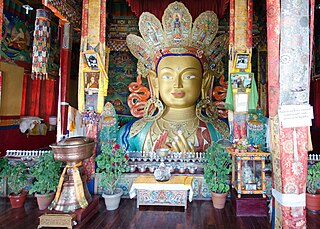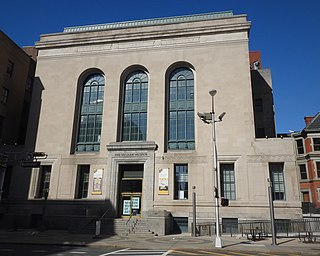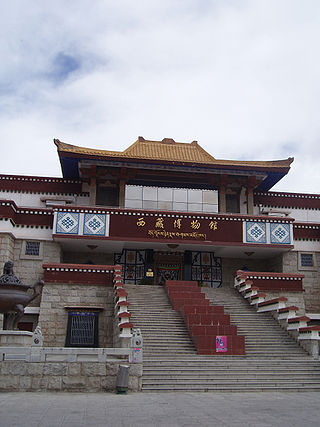Related Research Articles

A mandala is a geometric configuration of symbols. In various spiritual traditions, mandalas may be employed for focusing attention of practitioners and adepts, as a spiritual guidance tool, for establishing a sacred space and as an aid to meditation and trance induction. In the Eastern religions of Hinduism, Buddhism, Jainism and Shinto it is used as a map representing deities, or especially in the case of Shinto, paradises, kami or actual shrines.

Nalanda was a renowned Buddhist mahavihara in ancient and medieval Magadha, eastern India. Widely considered to be among the greatest centres of learning in the ancient world, it was located near the city of Rajagriha, roughly 90 kilometres (56 mi) southeast of Pataliputra. Operating from 427 CE until the 13th century, Nalanda played a vital role in promoting the patronage of arts and academics during the 5th and 6th century CE, a period that has since been described as the "Golden Age of India" by scholars.

The vast majority of surviving Tibetan art created before the mid-20th century is religious, with the main forms being thangka, paintings on cloth, mostly in a technique described as gouache or distemper, Tibetan Buddhist wall paintings, and small statues in bronze, or large ones in clay, stucco or wood. They were commissioned by religious establishments or by pious individuals for use within the practice of Tibetan Buddhism and were manufactured in large workshops by monks and lay artists, who are mostly unknown. Various types of religious objects, such as the phurba or ritual dagger, are finely made and lavishly decorated. Secular objects, in particular jewellery and textiles, were also made, with Chinese influences strong in the latter.

The Newark Museum of Art, formerly known as the Newark Museum, in Newark, Essex County, New Jersey is the state's largest museum. It holds major collections of American art, decorative arts, contemporary art, and arts of Asia, Africa, the Americas, and the ancient world. Its extensive collections of American art include works by Hiram Powers, Thomas Cole, John Singer Sargent, Albert Bierstadt, Frederick Church, Childe Hassam, Mary Cassatt, Edward Hopper, Georgia O'Keeffe, Joseph Stella, Tony Smith and Frank Stella.

A thangka is a Tibetan Buddhist painting on cotton, silk appliqué, usually depicting a Buddhist deity, scene, or mandala. Thangkas are traditionally kept unframed and rolled up when not on display, mounted on a textile backing somewhat in the style of Chinese scroll paintings, with a further silk cover on the front. So treated, thangkas can last a long time, but because of their delicate nature, they have to be kept in dry places where moisture will not affect the quality of the silk. Most thangkas are relatively small, comparable in size to a Western half-length portrait, but some are extremely large, several metres in each dimension; these were designed to be displayed, typically for very brief periods on a monastery wall, as part of religious festivals. Most thangkas were intended for personal meditation or instruction of monastic students. They often have elaborate compositions including many very small figures. A central deity is often surrounded by other identified figures in a symmetrical composition. Narrative scenes are less common, but do appear.

Dorje Shugden, also known as Dolgyal and Gyalchen Shugden, is an entity associated with the Gelug school, the newest of the schools of Tibetan Buddhism. Dorje Shugden is variously looked upon as a destroyed gyalpo, a minor mundane protector, a major mundane protector, an enlightened major protector whose outward appearance is that of a gyalpo, or as an enlightened major protector whose outward appearance is enlightened.

Vajrayoginī is an important figure in Buddhism, especially revered in Tibetan Buddhism. In Vajrayana she is considered a female Buddha and a ḍākiṇī. Vajrayoginī is often described with the epithet sarvabuddhaḍākiṇī, meaning "the ḍākiṇī [who is the Essence] of all Buddhas". She is an Anuttarayoga Tantra meditational deity (iṣṭadevatā) and her practice includes methods for preventing ordinary death, intermediate state (bardo) and rebirth (samsara) by transforming them into paths to enlightenment, and for transforming all mundane daily experiences into higher spiritual paths.

Buddhist art is visual art produced in the context of Buddhism. It includes depictions of Gautama Buddha and other Buddhas and bodhisattvas, notable Buddhist figures both historical and mythical, narrative scenes from their lives, mandalas, and physical objects associated with Buddhist practice, such as vajras, bells, stupas and Buddhist temple architecture. Buddhist art originated in the north of the Indian subcontinent, in modern India, Pakistan and Afghanistan, with the earliest survivals dating from a few centuries after the historical life of Siddhartha Gautama from the 6th to 5th century BCE.

Glenn H. Mullin is a Tibetologist, Buddhist writer, translator of classical Tibetan literature and teacher of Tantric Buddhist meditation.

In Tibetan Buddhism, Vajravārāhī is considered a female buddha and "the root of all emanations of dakinis". As such, Vajravarahi manifests in the colors of white, yellow, red, green, blue, and black. She is a popular deity in Tibetan Buddhism and in the Nyingma school she is the consort of Hayagriva, the wrathful form of Avalokiteshvara. She is also associated with the Cakrasaṃvara Tantra, where she is paired in yab-yum with the Heruka Cakrasaṃvara.

Tabo Monastery is located in the Tabo village of Spiti Valley, Himachal Pradesh, northern India. It was founded in 996 CE in the Tibetan year of the Fire Ape by the Tibetan Buddhist lotsawa (translator) Rinchen Zangpo, on behalf of the king of western Himalayan Kingdom of Guge, Yeshe-Ö. Tabo is noted for being the oldest continuously operating Buddhist enclave in both India and the Himalayas. A large number of frescoes displayed on its walls depict tales from the Buddhist pantheon. There are many priceless collections of thankas, manuscripts, well-preserved statues, frescos and extensive murals which cover almost every wall. The monastery is in need of refurbishing as the wooden structures are aging and the thanka scroll paintings are fading. After the earthquake of 1975, the monastery was rebuilt, and in 1983 a new Du-kang or Assembly Hall was constructed. It is here that the 14th Dalai Lama held the Kalachakra ceremonies in 1983 and 1996. The monastery is protected by the Archaeological Survey of India (ASI) as a national historic treasure of India.

Tholing Monastery is the oldest monastery in the Ngari Prefecture of western Tibet. It is situated in Tholing (Zanda), Zanda County, near the Indian border of Ladakh. It was built in 997 AD by Yeshe-Ö, the second King of the Guge Kingdom. In Tibetan language 'Tholing' means "hovering in the sky forever" and is reflected by the location of the monastery at an elevation of 12,400 feet (3,800 m). The complex includes three temples, the Yeshe-O Temple, the Lhakhang Karpo and the Dukhang. There are many ancient, precious, and well-preserved frescoes.

The Tibet Museum is the official museum of the Tibet Autonomous Region of China in Lhasa. Inaugurated on October 5, 1999, it is the first large, modern museum in the Tibet Autonomous Region. It has a collection of more than 520,000 artifacts, including pottery, jade, and Buddha statues, attracting hundreds of thousands of visitors every year. It has a collection of around 1,000 artifacts permanently on display related to the cultural history of Tibet, from examples of Tibetan art to architectural design throughout history such as Tibetan doors and beams. In order to fill the museum the Tibet aristocracy and religious establishment had their property confiscated by the Chinese Government.

Purang-Guge kingdom was a small Western Himalayan kingdom which was founded and flourished in the 10th century in western Tibet.
The Treasury of Lives is an online, open access, peer reviewed, collection of biographical essays, which can be seen as an encyclopedia of historical figures from Tibet, Inner Asia, and the Himalayan Region.
Jeff Watt is a scholar and curator of Himalayan and Tibetan Art and well known translator of Tibetan texts.
Pratapaditya Pal is an Indian scholar of Southeast Asian and Himalayan art and culture, specializing particularly in the history of art of India, Nepal and Tibet. He has served as a curator of South Asian art at several prominent US museums including Boston's Museum of Fine Arts, the Los Angeles County Museum of Art, and the Art Institute of Chicago, where he has organized more than 22 major exhibitions and helped build the museums' collection. He has also written over 60 books and catalogs, and over 250 articles on the subject, taught at several universities, and served as the editor of the Indian art magazine, Marg. In 2009 he was awarded Padma Shri by the Government of India for his contributions to the study of Indian art.
The Buddhist Digital Resource Center (BDRC), formerly Tibetan Buddhist Resource Center (TBRC), is a 501(c)(3) nonprofit organization dedicated to seeking out, preserving, organizing, and disseminating Buddhist literature. Joining digital technology with scholarship, BDRC ensures that the ancient wisdom and cultural treasures of the Buddhist literary tradition are not lost, but are made available for future generations. BDRC is committed to seeking out, preserving, organizing, and disseminating Buddhist literature. Founded in 1999 by E. Gene Smith with the help of the Tibetan translator Michele Martin, BDRC is located in Cambridge, Massachusetts, and hosts a digital library of the largest collection of digitized Tibetan texts in the world. Current programs focus on the preservation of texts in Pali, Chinese, Sanskrit, and Tibetan.
John Clarke (1954-2020) was a British specialist in Ladakhi and Tibetan metalwork. He was Curator of Himalayan and Southeast Asian Art at the Victoria and Albert Museum.
References
- ↑ "Online Resources". Rubin Museum of Art. Archived from the original on July 22, 2014.
- ↑ "Who hijacked Himalayan art? Or any art, for that matter?". Tricycle, Aug 06, 2010
- ↑ "Oglethorpe to Award Two Honorary Degrees During Saturday's Commencement for 2013 Grads". Oglethorpe University. Retrieved February 6, 2016.
- ↑ "Rubin Foundation awards $777,000 in grants to organizations aligned with art and social justice". Lion's Roar, by Lilly Greenblatt| February 6, 2018
- ↑ "Himalayan Buddhism". Tribune India, May 8, 2016,
- ↑ "Collecting Guide: Buddhist sculpture". Christie's, access date December 3, 2016.
- ↑ Selva J. Raj (2013). South Asian Religions: Tradition and Today. Routledge. pp. 16–. ISBN 978-0-415-44851-2.
- ↑ Stefan Larsson. Crazy for Wisdom: The Making of a Mad Yogin in Fifteenth-Century Tibet . BRILL; 14 September 2012. ISBN 978-90-04-23287-7. p. 293–.
- ↑ "On Bells, Whistles, Hats, and Number Sets: An Interview with Jeff Watt on Buddhist Iconography and Himalayan Art". By Anne Wisman, Buddhistdoor Global, 2018-03-23
- ↑ Melissa R. Kerin (September 2009). Artful Beneficence: Selections from the David R. Nalin Himalayan Art Collection. Rubin Museum of Art. p. 10. ISBN 978-0-9772131-5-3.
- ↑ Asian Studies Newsletter. Vol. 52. Association for Asian Studies. 2007. p. 27.